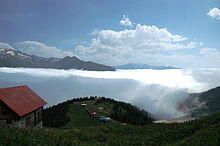
Trabzon, historically known as Trebizond, is a city on the Black Sea coast of northeastern Turkey and the capital of Trabzon Province. Trabzon, located on the historical Silk Road, became a melting pot of religions, languages and culture for centuries and a trade gateway to Persia in the southeast and the Caucasus to the northeast. The Venetian and Genoese merchants paid visits to Trabzon during the medieval period and sold silk, linen and woolen fabric. Both republics had merchant colonies within the city – Leonkastron and the former "Venetian castle" – that played a role to Trabzon similar to the one Galata played to Constantinople. Trabzon formed the basis of several states in its long history and was the capital city of the Empire of Trebizond between 1204 and 1461. During the early modern period, Trabzon, because of the importance of its port, again became a focal point of trade to Persia and the Caucasus.

Erzurum Province is a province and metropolitan municipality in the Eastern Anatolia Region of Turkey. Its area is 25,006 km2, and its population is 749,754 (2022). The capital of the province is the city of Erzurum. It’s the fourth largest province in all of Turkey. It is bordered by the provinces of Kars and Ağrı to the east, Muş and Bingöl to the south, Erzincan and Bayburt to the west, Rize and Artvin to the north and Ardahan to the northeast. The governor of the province is Mustafa Çiftçi, appointed in August 2023. The province has an overall Turkish-majority.

Trabzon Province is a province and metropolitan municipality of Turkey on the Black Sea coast. Its area is 4,628 km2, and its population is 818,023 (2022). Located in a strategically important region, Trabzon is one of the oldest trade port cities in Anatolia. Neighbouring provinces are Giresun to the west, Gümüşhane to the southwest, Bayburt to the southeast and Rize to the east. Aziz Yıldırım was appointed Governor of the province in August 2023. The capital of the province is Trabzon.

The Hemshin people, also known as Hemshinli or Hamshenis or Homshetsi, are a bilingual small group of Armenians who practice Sunni Islam after they had been converted from Christianity in the beginning of the 18th century and are affiliated with the Hemşin and Çamlıhemşin districts in the province of Rize, Turkey. They are Armenian in origin, and were originally Christian members of the Armenian Apostolic Church, but over the centuries evolved into a distinct community and converted to Sunni Islam after the conquest of the region by the Ottomans during the second half of the 15th century.

Rize is a coastal city in the eastern part of the Black Sea Region of Turkey. It is the seat of Rize Province and Rize District. Its population is 119,828 (2021). Rize is a typical Turkish provincial capital with little in the way of nightlife or entertainment. Since the border with Georgia was opened in the early 1990s, the Black Sea coast road has been widened and the town is much wealthier than it used to be. Current Turkish President Recep Tayyip Erdoğan's family has its roots in Rize and the local university is named after him. The city is linked by road with Trabzon, Hopa (55 miles [88 km] east on the Georgian border, and Erzurum. Rize–Artvin Airport started operating in 2022.
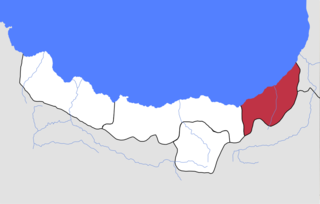
Lazistan was the Ottoman administrative name for the sanjak, under Trebizond Vilayet, comprising the Laz or Lazuri-speaking population on the southeastern shore of the Black Sea. It covered modern day land of contemporary Rize Province and the littoral of contemporary Artvin Province.
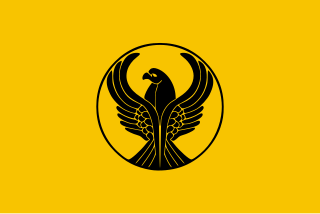
The Pontic Greeks, also Pontian Greeks or simply Pontians, are an ethnically Greek group indigenous to the region of Pontus, in northeastern Anatolia. Many later migrated in various waves between the Ottoman conquest of the Empire of Trebizond in 1461 and the Russo-Turkish War of 1828–1829. Common migratory destinations included other parts of Eastern Anatolia, the former Russian province of Kars Oblast in the Transcaucasus, and the country of Georgia.

The tulum is a musical instrument, a form of bagpipe from the Black Sea region of Turkey. It is droneless with two parallel chanters, and is usually played by the Laz, Black sea Turks, Hemshin peoples and by Pontic Greeks, particularly Chaldians. It is a prominent instrument in the music of Pazar, Hemşin, Çamlıhemşin, Ardeşen, Fındıklı, Arhavi, Hopa, some other districts of Artvin and in the villages of the Tatos range of İspir. It is the characteristic instrument of the transhumant population of the northeastern provinces of Anatolia and, like the kemençe in its area, the tulum imposes its style on all the dance and entertainment music of those for whom it is "our music".
Ardeşen is a town in Rize Province in the Black Sea region of Turkey, 48 km (30 mi) along the coast road from the city of Rize. It is the seat of Ardeşen District. Its population is 30,645 (2021).

Çamlıhemşin, formerly Vice, is a small town in Rize Province in the Black Sea region of Turkey. It is the seat of Çamlıhemşin District. Its population is 1,763 (2021).

Pazar is a town in Rize Province in the Black Sea region of Turkey, 37 km east of the city of Rize. It is the seat of Pazar District. Its population is 17,946 (2021). The town contains many inhabitants of Laz and Georgian ancestries as well as other peoples. The town consists of the quarters Gazi, Kocaköprü, Ocak, Beyaztaş, Güzelyalı, Zafer, İkiztepe, Kirazlık, Cumhuriyet, Pazar, Soğuksu and Yukarı Soğuksu.

Hemşin, is a town in Rize Province in the Black Sea region of Turkey, 57 km from the city of Rize. It is the seat of Hemşin District. Its population is 1,472 (2021).

Hopa is a town in Artvin Province in northeast Turkey. It is located on the eastern Turkish Black Sea coast about 67 km (42 mi) from the city of Artvin and 18 kilometres from the border with Georgia. It is the seat of Hopa District. Its population is 23,846 (2021).
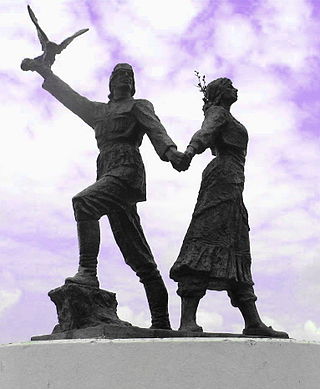
The Laz people, or Lazi, are a Kartvelian ethnic group native to the South Caucasus, who mainly live in Black Sea coastal regions of Turkey and Georgia. They traditionally speak the Laz language but have experienced a rapid language shift to Turkish.

İkizdere is a town in Rize Province in the Black Sea region of Turkey. It is the seat of İkizdere District. Its population is 1,875 (2021).

Zilkale is a medieval castle located in the Fırtına Valley within the Pontic Mountains, and is one of the most important historical structures in the Çamlıhemşin district of Rize Province, within the Black Sea Region of Turkey.

The Black Sea Region is a geographical region of Turkey. The largest city in the region is Samsun. Other big cities are Zonguldak, Trabzon, Ordu, Tokat, Giresun, Rize, Amasya and Sinop.
The Principality of Hamamshen was a small principality established in about 790 by Armenians who fled the Arab invasions of Armenia and the creation of the Muslim Arab-ruled state of Arminiya.
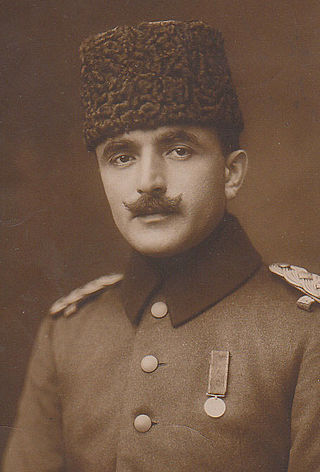
Place name changes in Turkey have been undertaken, periodically, in bulk from 1913 to the present by successive Turkish governments. Thousands of names within the Turkish Republic or its predecessor the Ottoman Empire have been changed from their popular or historic alternatives in favour of recognizably Turkish names, as part of Turkification policies. The governments have argued that such names are foreign or divisive, while critics of the changes have described them as chauvinistic. Names changed were usually of Armenian, Greek, Georgian, Laz, Bulgarian, Kurdish (Zazaki), Persian, Syriac, or Arabic origin.

Fırtına or Peruma is one of the main water streams of Rize Province in the eastern Black Sea Region of Turkey. Its name is Turkish for "storm water". There is a group of more than 20 well-preserved Ottoman-era bridges over the Fırtına Deresi.









